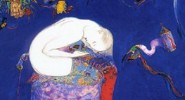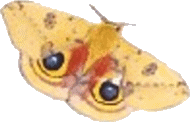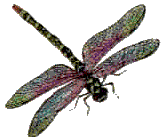Tuesday, May 11, 2004
Posted by Artichoke Heart | 5:34 PM |
Monday, May 10, 2004
HEAD-SMASHED-IN
[I'm back from my reading in Asheville, and have been in the process of getting my regular groove back, and ridding myself of the last bit of Onerous Lung Fungus. I've been meaning to post, but I've been rather distracted, so I thought that in the meantime, I'd post my introductory editor's essay for the spring issue of South Dakota Review, which is due out in a matter of weeks now. This will be, in fact, my last editor's essay for the magazine, as I resigned a few weeks back . . . what's more, you, Dear Readers, will get to see the version with links to pictures! More soon on the Asheville trip, dogs, cats, and other stuff.]
Everyone assumes the name of the buffalo jump, Head-Smashed-In, refers to the crushed skulls of the buffalo who were driven in thunderous, stampeding herds over the rocky promontory of the cliff to fall to their death on the kill site below. The Native name for Head-Smashed-In buffalo jump, however, estipah sikini kots, translates loosely into “where he got his head smashed in,” and refers to the legend of a young Peigan Indian man who, approximately 150 years ago, wanted to watch the buffalo cascading, like the inside view of a waterfall, from within the cliff itself. He cached himself within a hollow inside the cliff, but the herd of buffalo driven over the buffalo jump that day was so large that the young man ended up being trapped inside the cliff by the suffocating tonnage of fallen buffalo. When his body was finally recovered, it was sorrowfully discovered that his skull had been crushed.
Located in Southern Alberta, Head-Smashed-In buffalo jump is one of the oldest known and best-preserved buffalo jumps. Regularly used for over 5,000 years, guidebooks to Southern Alberta repeatedly attempt to put this number into perspective by pointing out that Head-Smashed-In was in use well before the building of the Egyptian Pyramids or the erection of Stonehenge. Archaeologists were able to chart technological developments, as well as the effects of encroaching white immigrants, through analyzing the evolution of tools employed by the Native tribes who used the buffalo jump -- bone, stone, and metal -- and recovered through a study of the progressive historical layers of artifacts unearthed at the kill site. It’s not the archaeological tracking of technological innovation that captivates and haunts the visitor to Head-Smashed-In, however, rather it’s the overwhelming sense of history, cultural tradition, and sacred ritual.
Head-Smashed-In was selected by Native peoples as a buffalo jump site for the proximity of a gathering basin to the cliff face. Comprised of prime grazing area, bison herds would be periodically drawn to the gathering basin when conditions were right. Furthermore, the constant presence of chinook winds blowing in the direction of the cliff ensured that the buffalo would not be spooked too soon or driven away in the wrong direction through detection of a human scent. A successful buffalo hunt required patience, good-timing, courage, and skill -- furthermore, the bounty of a good hunt was a necessity for any given tribe to survive the harsh Canadian winters. Prior to the buffalo jump, as herds were approaching the gathering basin, songs were sung to the spirit of the buffalo and men, women, and children carried buffalo-shaped stones and fossils with them for good luck.
The choreography of the buffalo jump was intricate. Young men disguised as buffalo calves interspersed themselves within the herd in the gathering basin, imitating the bleating of calves, and prompting the herd to begin to move. Other members of the tribe who had hidden themselves behind large stone cairns, designed to guide the buffalo in the direction of the cliff, would emerge from behind the cairns, waving blankets, to keep the buffalo moving in the right direction. Approximately eighteen kilometers from the actual cliff, V-shaped drive lanes pointed toward the steepest point of the cliff, and it was here that buffalo runners shouted and waved blankets at the bison herd, whipping them into a frenzied stampede and channeling them into the drive lanes that led directly over the edge of the cliff. At the kill site below, any bison which hadn’t been mortally injured by the fall were killed, and ceremonies to honor the buffalo were performed. Carcasses were then eventually moved one by one to the camping and processing site where they were butchered and skinned.
The Head-Smashed-In Interpretive Centre, which is run by local Peigan Indians, is truly impressive. Architecturally designed to blend in unobtrusively with the sandstone cliff face, the building consists of multiple levels that allow the visitor to gradually make their way up to the uppermost floor, where they can then step outside and view the stunning vista from the top of the cliff. Inside the Interpretive Centre, stuffed bison are frozen in time in mid-run as they perch on the promontory of a cliff overlooking one of the levels of the museum floor. There is a wall-length window of buffalo skulls, rooms full of Native artifacts, and a movie theater where one can view a film that details the history and ritual of the buffalo jump. In a display case, one can look at the many ingenious ways that buffalo parts were used -- a gorgeously-painted skull as decoration, a bladder as water bottle, bones and horns as tools and scrapers. I have my picture taken companionably hugging the wooly head of one of the more friendly-looking stuffed bison located underneath one of the many staircases.
Outside the Interpretive Centre and at the top of the cliff, the view is breathtaking. It is mid-August, and the sky has an odd, silky-gray overcast quality -- not from weather, however, but rather from smoke. During the dry months of summer, there has been a dangerous increase in fires, and substantive portions of the Crow’s Nest Pass, the mountain pass which connects Southern Alberta and British Columbia, as well as the Okanagan valley region in British Columbia, have been in flame for several weeks now. The smell of burning pine smudges the air. Perhaps one of the most disconcerting long-distance visual effects of the forest fires are that even though Head-Smashed-In is situated in the Porcupine Hills, which limn the base of the Canadian Rockies, the mountains themselves, which typically dominate the horizon, are completely invisible in the delicate haze. It is as if they have been completely erased . . . as if they were never even there.
Like the troubling uncertainty of the mountains being eclipsed in a smoky chiffon veil, one can’t help but feel similarly disquieted by thoughts of erasure, loss, evanescence, and flux, while standing at the top of the cliff at Head-Smashed-In, looking out over miles and miles of wind-ruffled prairie below. For over 5,000 years there was the deafening clamor of stampeding hooves, the unimaginable sound of as many as 300 buffalo raining down from the sky and falling to the earth, the songs sung to the spirit of the buffalo lacing the air like the silky warble of a meadowlark, and now there is only the song of the wind . . . and silence.
[I'm back from my reading in Asheville, and have been in the process of getting my regular groove back, and ridding myself of the last bit of Onerous Lung Fungus. I've been meaning to post, but I've been rather distracted, so I thought that in the meantime, I'd post my introductory editor's essay for the spring issue of South Dakota Review, which is due out in a matter of weeks now. This will be, in fact, my last editor's essay for the magazine, as I resigned a few weeks back . . . what's more, you, Dear Readers, will get to see the version with links to pictures! More soon on the Asheville trip, dogs, cats, and other stuff.]
Everyone assumes the name of the buffalo jump, Head-Smashed-In, refers to the crushed skulls of the buffalo who were driven in thunderous, stampeding herds over the rocky promontory of the cliff to fall to their death on the kill site below. The Native name for Head-Smashed-In buffalo jump, however, estipah sikini kots, translates loosely into “where he got his head smashed in,” and refers to the legend of a young Peigan Indian man who, approximately 150 years ago, wanted to watch the buffalo cascading, like the inside view of a waterfall, from within the cliff itself. He cached himself within a hollow inside the cliff, but the herd of buffalo driven over the buffalo jump that day was so large that the young man ended up being trapped inside the cliff by the suffocating tonnage of fallen buffalo. When his body was finally recovered, it was sorrowfully discovered that his skull had been crushed.
Located in Southern Alberta, Head-Smashed-In buffalo jump is one of the oldest known and best-preserved buffalo jumps. Regularly used for over 5,000 years, guidebooks to Southern Alberta repeatedly attempt to put this number into perspective by pointing out that Head-Smashed-In was in use well before the building of the Egyptian Pyramids or the erection of Stonehenge. Archaeologists were able to chart technological developments, as well as the effects of encroaching white immigrants, through analyzing the evolution of tools employed by the Native tribes who used the buffalo jump -- bone, stone, and metal -- and recovered through a study of the progressive historical layers of artifacts unearthed at the kill site. It’s not the archaeological tracking of technological innovation that captivates and haunts the visitor to Head-Smashed-In, however, rather it’s the overwhelming sense of history, cultural tradition, and sacred ritual.
Head-Smashed-In was selected by Native peoples as a buffalo jump site for the proximity of a gathering basin to the cliff face. Comprised of prime grazing area, bison herds would be periodically drawn to the gathering basin when conditions were right. Furthermore, the constant presence of chinook winds blowing in the direction of the cliff ensured that the buffalo would not be spooked too soon or driven away in the wrong direction through detection of a human scent. A successful buffalo hunt required patience, good-timing, courage, and skill -- furthermore, the bounty of a good hunt was a necessity for any given tribe to survive the harsh Canadian winters. Prior to the buffalo jump, as herds were approaching the gathering basin, songs were sung to the spirit of the buffalo and men, women, and children carried buffalo-shaped stones and fossils with them for good luck.
The choreography of the buffalo jump was intricate. Young men disguised as buffalo calves interspersed themselves within the herd in the gathering basin, imitating the bleating of calves, and prompting the herd to begin to move. Other members of the tribe who had hidden themselves behind large stone cairns, designed to guide the buffalo in the direction of the cliff, would emerge from behind the cairns, waving blankets, to keep the buffalo moving in the right direction. Approximately eighteen kilometers from the actual cliff, V-shaped drive lanes pointed toward the steepest point of the cliff, and it was here that buffalo runners shouted and waved blankets at the bison herd, whipping them into a frenzied stampede and channeling them into the drive lanes that led directly over the edge of the cliff. At the kill site below, any bison which hadn’t been mortally injured by the fall were killed, and ceremonies to honor the buffalo were performed. Carcasses were then eventually moved one by one to the camping and processing site where they were butchered and skinned.
The Head-Smashed-In Interpretive Centre, which is run by local Peigan Indians, is truly impressive. Architecturally designed to blend in unobtrusively with the sandstone cliff face, the building consists of multiple levels that allow the visitor to gradually make their way up to the uppermost floor, where they can then step outside and view the stunning vista from the top of the cliff. Inside the Interpretive Centre, stuffed bison are frozen in time in mid-run as they perch on the promontory of a cliff overlooking one of the levels of the museum floor. There is a wall-length window of buffalo skulls, rooms full of Native artifacts, and a movie theater where one can view a film that details the history and ritual of the buffalo jump. In a display case, one can look at the many ingenious ways that buffalo parts were used -- a gorgeously-painted skull as decoration, a bladder as water bottle, bones and horns as tools and scrapers. I have my picture taken companionably hugging the wooly head of one of the more friendly-looking stuffed bison located underneath one of the many staircases.
Outside the Interpretive Centre and at the top of the cliff, the view is breathtaking. It is mid-August, and the sky has an odd, silky-gray overcast quality -- not from weather, however, but rather from smoke. During the dry months of summer, there has been a dangerous increase in fires, and substantive portions of the Crow’s Nest Pass, the mountain pass which connects Southern Alberta and British Columbia, as well as the Okanagan valley region in British Columbia, have been in flame for several weeks now. The smell of burning pine smudges the air. Perhaps one of the most disconcerting long-distance visual effects of the forest fires are that even though Head-Smashed-In is situated in the Porcupine Hills, which limn the base of the Canadian Rockies, the mountains themselves, which typically dominate the horizon, are completely invisible in the delicate haze. It is as if they have been completely erased . . . as if they were never even there.
Like the troubling uncertainty of the mountains being eclipsed in a smoky chiffon veil, one can’t help but feel similarly disquieted by thoughts of erasure, loss, evanescence, and flux, while standing at the top of the cliff at Head-Smashed-In, looking out over miles and miles of wind-ruffled prairie below. For over 5,000 years there was the deafening clamor of stampeding hooves, the unimaginable sound of as many as 300 buffalo raining down from the sky and falling to the earth, the songs sung to the spirit of the buffalo lacing the air like the silky warble of a meadowlark, and now there is only the song of the wind . . . and silence.
Posted by Artichoke Heart | 7:48 PM |












